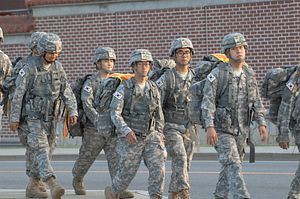On Monday, South Korea said that its defense budget would grow markedly over the next five years amid a growing perception of threats from North Korea.
According to Yonhap News, South Korean defense spending will grow by $214.7 billion (232 trillion won) between 2016 and 2020. The annual rate of increase will be roughly 7 percent.
About $143.2 billion of the projected budget injection will go toward the maintenance cost of troops and the remainder will go toward improving military capabilities, including investments in research and development for South Korea’s preemptive strike, missile defense, and air defense apparatuses.
This will include the South Korea’s Kill Chain, Korean Air and Missile Defnese (KAMD) system, and other initiatives.
KAMD is similar to what the United States is offering South Korea with the controversial Terminal High-Altitude Area Defense (THAAD) system—THAAD has drawn criticism from China which sees the technology as damaging to its national interests.
With a fully implemented Kill Chain, South Korea would theoretically be able to counter any North Korean preemptive attack within minutes in a war scenario.
Specifically, South Korea will invest $5.5 billion in the Kill Chain preemptive strike apparatus, and $2.5 billion in KAMD.
Reports that South Korea will increase its defense spending come amid competing threat assessments from Seoul and Washington regarding the state of North Korea’s nuclear weapons program and overall military readiness.
U.S. officials maintain that they believe that North Korea has successfully managed to miniaturize its nuclear devices for delivery via its KN-08 intercontinental ballistic missiles, an assessment senior South Korean defense officials have rejected.
“Our assessment is that they have the ability to put a nuclear weapon on a KN-08 and shoot it at the homeland,” Adm. William Gortney of U.S. Northern Command noted two weeks ago.
South Korean Vice Defense Minister Baek Seung-joo noted that Gortney’s remarks were “not made with a thorough assessment of North Korea’s capabilities.”
South Korea’s planned defense spending increase is also related to the ongoing process with the United States to shift wartime operational control (OPCON) of South Korean troops from Washington to Seoul.
The two allies met repeatedly to discuss OPCON transfer last year and ultimately agreed in October that Seoul needed more time to prepare for wartime control of its forces.
Currently, South Korea maintains peacetime control over its own troops, but in a war scenario, the commander of U.S. Forces Korea, currently General Curtis M. Scaparrotti, would exercise operational control over the U.S.-South Korea allied forces.
































